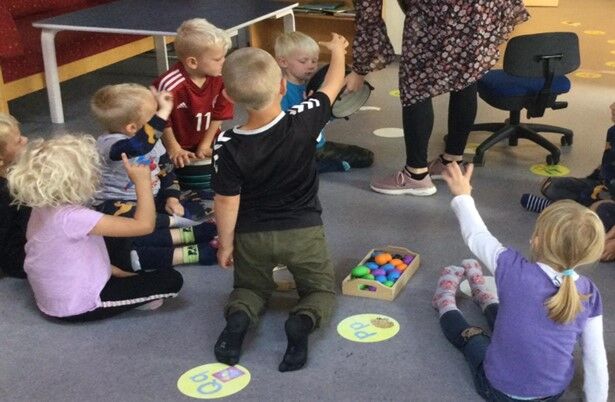MUSIC, AESTHETIC PROCESSES, COMMUNITY, EDUCATION
REGION: North
MUNICIPALITY: Hjørring
PROCEDURE: 2021
DAILY OFFER: Børnehuset Regnbuen Hundelev
Snow story: Børnehuset Regnbuen Hundelev (2021)
Language and relationship strengthening through music
Børnehuset Regnbuen Hundelev is a small kindergarten in two houses. In one house is the reception group, which consists of 2.9 to 4.5-year-old children. In the other is the pavilion with the oldest children.
The following text will first discuss the observations that have led to the overall wonder. Next, the wondering itself will be described in the form of a question, after which the aesthetic processes will be explained. Finally, it will reflect on what the play art has contributed and what the kindergarten will continue to work on in the future.
Observations & wonder
In the children's house, the educators have observed that some children had difficulty participating in gatherings where there were demanding situations. This made children who already had relational and language challenges feel unsafe.
The overarching question is therefore: How can we use PlayArt to engage relational and linguistically challenged children in activities that make them feel safe enough to actively participate in the sessions.
The aesthetic processes
Based on this wondering, music educator Signe (the artist) was brought in. The artist, daycare center managers, pedagogical staff and the play art supervisor met for a start-up reflection. Together they created the aesthetic framework for the common third. They started the approach by having breakfast with Signe to create a relationship before the music session. Then the playfulness began, where there were inlaid demand situations in songs such as "Hocus pocus, I'll turn you into crabs", where the children took turns choosing what they wanted to be turned into. Furthermore, songs were sung that sharpened concentration, such as "Olsen's old Ford car". Finally, the children took turns in groups of two and two to play the snare drum, while the other children lay down and relaxed, "See you again song - we have played and played..." was sung while they took turns going to the toilet and getting ready for the eating situation.
Everyday repetitive events and trivial processes were thus transformed into aesthetic and experiential events. The songs have been frame songs or games. This has also contributed to the children staying in the activity.
After a few times, even the children with relationship and language difficulties became comfortable with the familiar setting and started raising their hands. Suddenly one day, a child took on the role of the artist "Music-Signe" when he had found a stick to do magic with "Hocus pocus, I'll turn you into ants ...." The educators and the other children playfully seized the initiative and followed the trail - for a long time they sang and played "musicSigne".
The child expands their understanding of the world and develops themselves. Play thus contributes to children's education.
Additional collaborative input from the music artist was the creation of a sensory room inspired by quiet meditative instruments, focusing on the senses of hearing and sight.
What playfulness has contributed
It has become more permissible to let loose and be more playful with the children, a good safe space has been created, it has been fantastic. Having immersion over a longer period of time provides a better opportunity to follow the children's tracks and seize what develops in everyday life. What we have become curious about is how new children can be included in the existing group and how we can become even better at involving the children. The meditative instruments have created a calmer atmosphere. We will take the work with flow into other situations in everyday life. LegeKunst has thus been a good external input to kick-start curiosity.
The hocus-pocus song where the children are ants and crabs and the child is "musicSigne".
The song: Olsen's old Fordwagen
click on the picture to see a larger version


